Abstract
The relationship between changes in H+ flux and sugar transport in maize Zea mays L. DEA root tips have been investigated using two methods for controlling the cellular nucleotide level: (a) incubation in the presence of a glucose analog, the 2-deoxyglucose, which decreased the ATP level to less than 15% of its initial value within 60 minutes without changing the ADP and AMP levels; (b) an hypoxic treatment which also decreased the ATP level but with a concomitant rise in ADP and AMP. In both cases the rate of hexose transport was not modified until ATP had dropped to 70% of its initial value; then it decreased with the cellular ATP level. The residual uptake rate at very low ATP concentrations still represented 50% of the maximum rate with the dGlc treatment but only the diffusion rate in anoxia. H+ efflux was abolished in anoxia but not by the 2-deoxyglucose treatment, in spite of a lower cellular ATP concentration. Our results are consistent with an inhibition of H+-ATPase activity in anoxia by the high levels of cellular ADP and AMP, and provide in vivo evidence that sugar uptake is dependent upon the proton motive force rather than cellular ATP concentration. The absence of stimulation of H+ extrusion by ferricyanide in either normoxic or hypoxic conditions suggests that a redox system does not appear to contribute to H+ secretion under the conditions of this investigation.
Full text
PDF
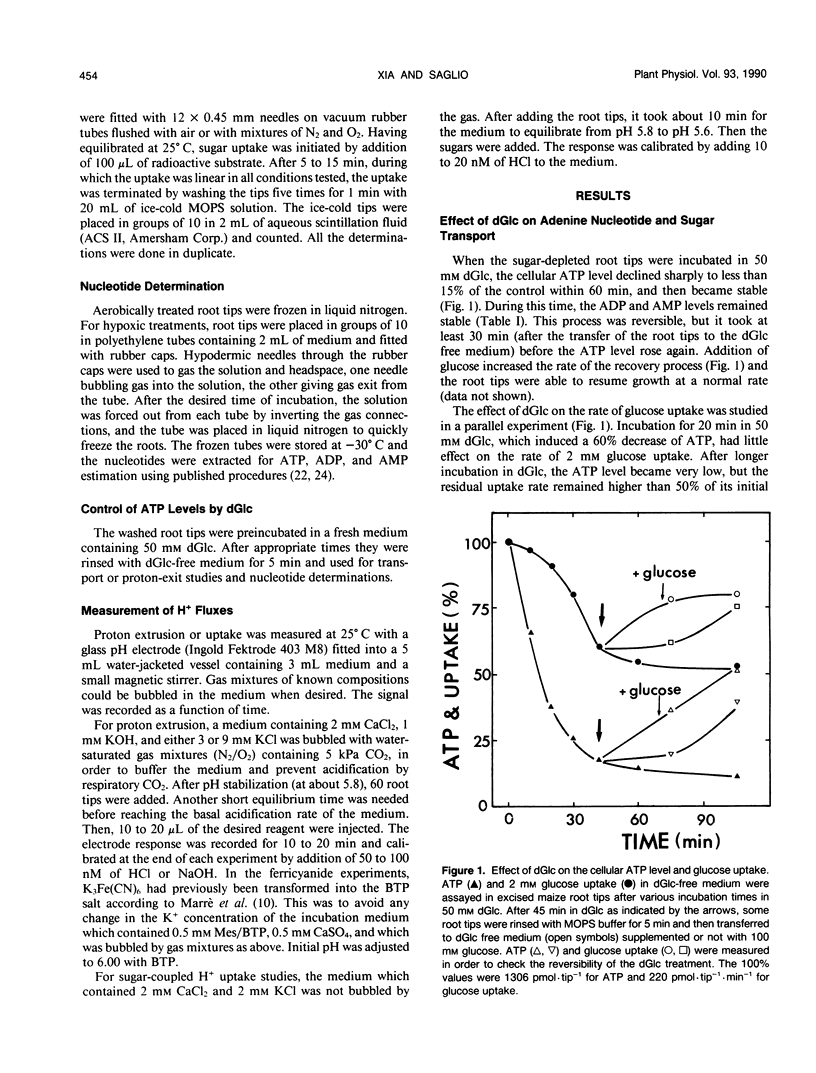
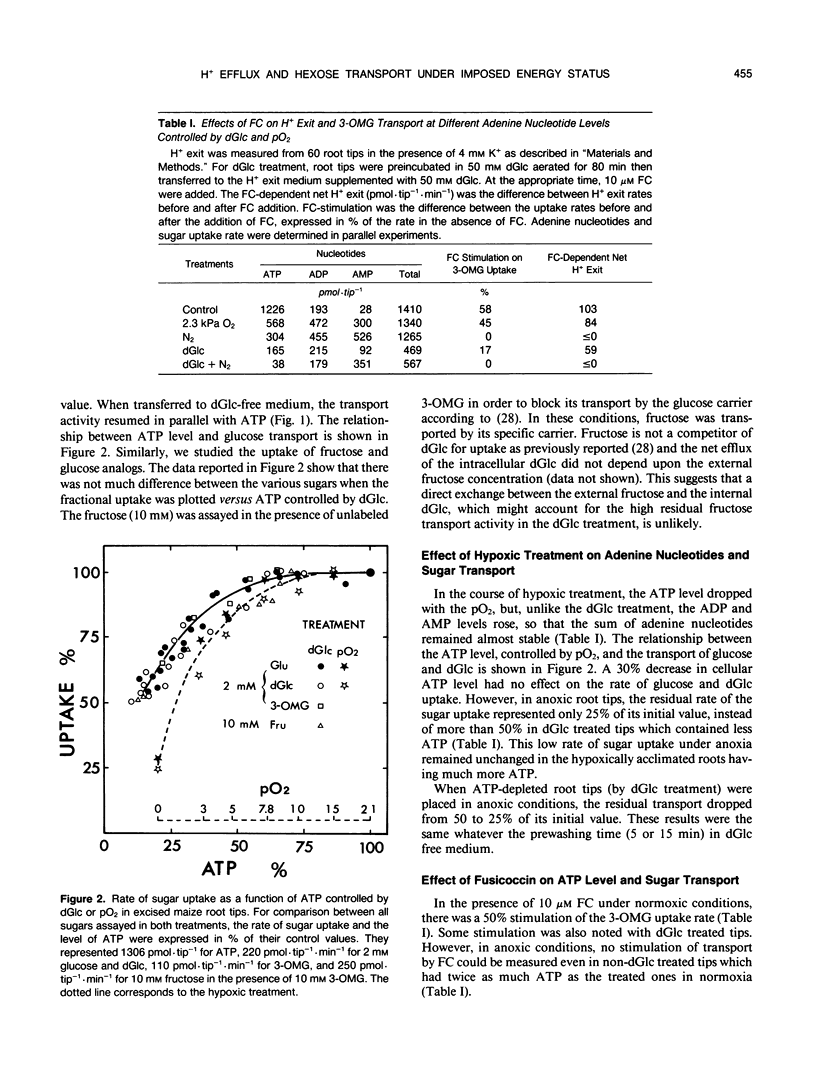

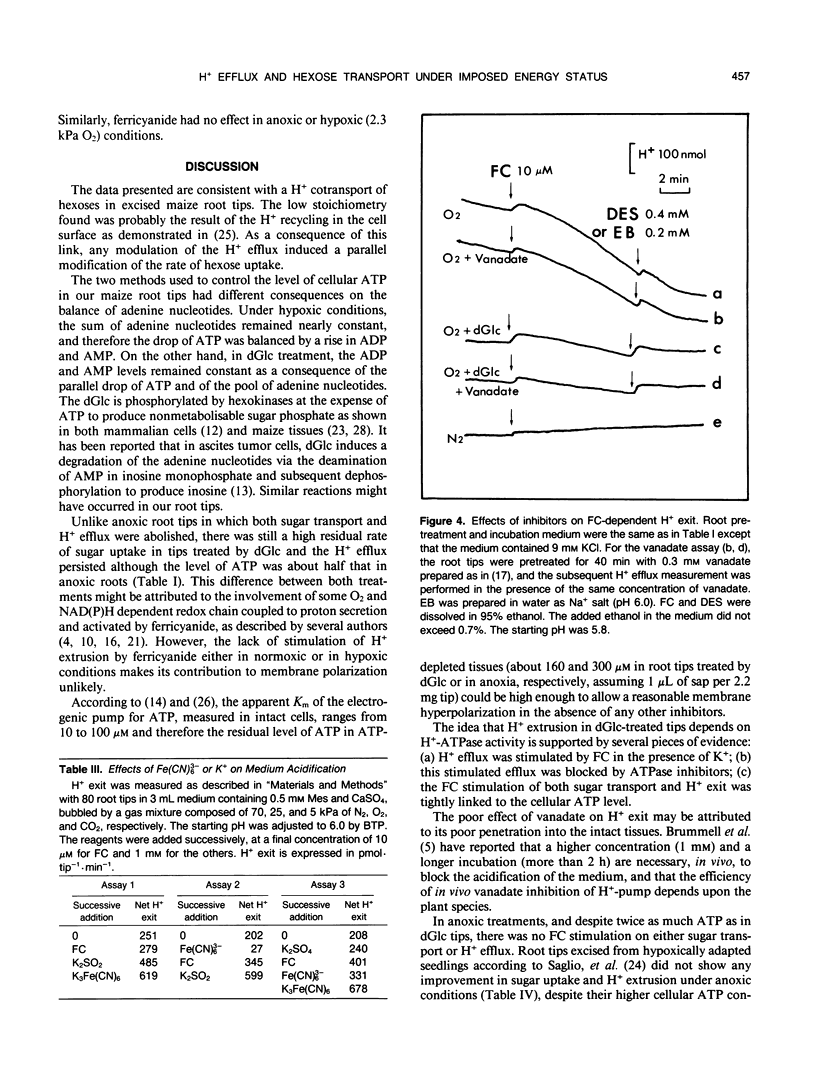
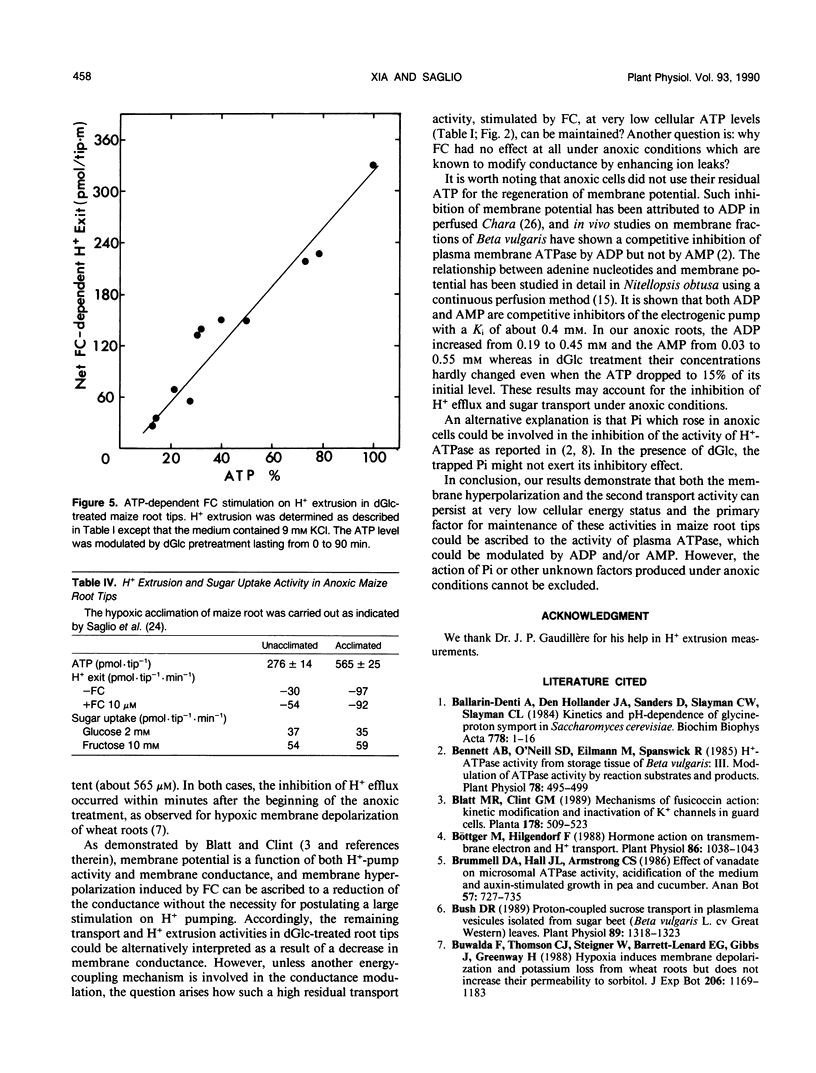
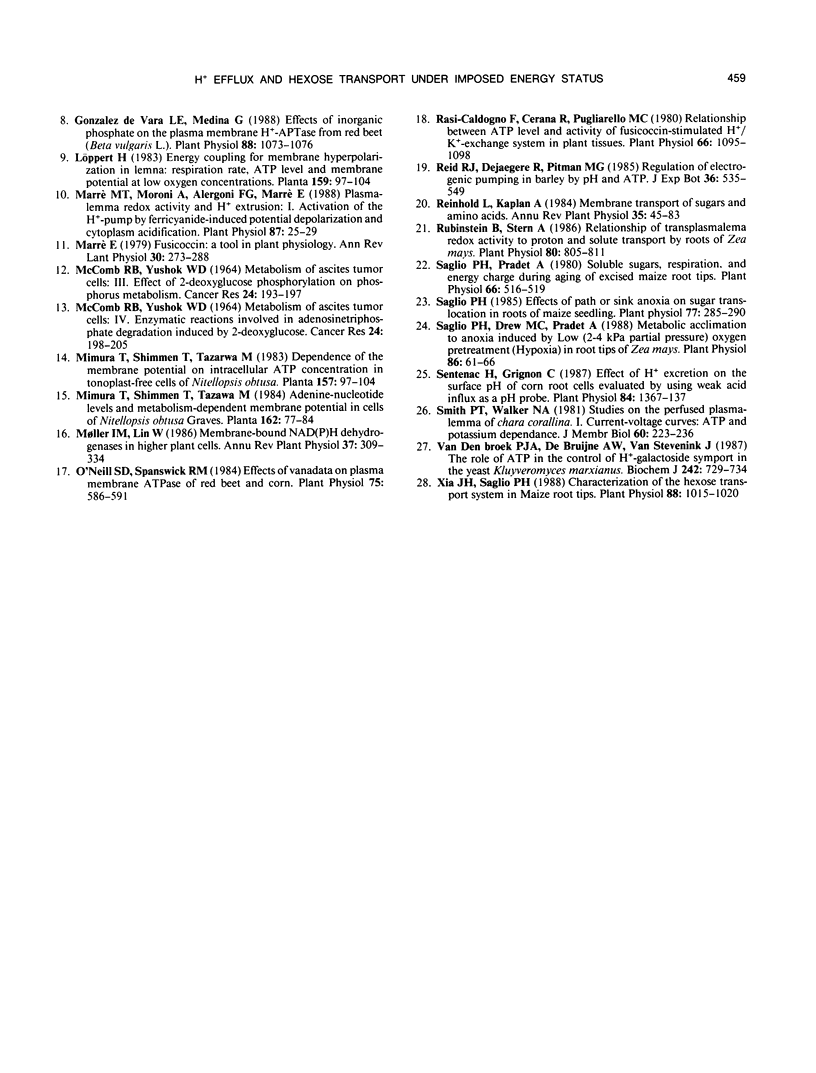
Selected References
These references are in PubMed. This may not be the complete list of references from this article.
- Ballarin-Denti A., Den Hollander J. A., Sanders D., Slayman C. W., Slayman C. L. Kinetics and pH-dependence of glycine-proton symport in Saccharomyces cerevisiae. Biochim Biophys Acta. 1984 Nov 21;778(1):1–16. doi: 10.1016/0005-2736(84)90442-5. [DOI] [PubMed] [Google Scholar]
- Bennett A. B., O'neill S. D., Eilmann M., Spanswick R. M. H-ATPase Activity from Storage Tissue of Beta vulgaris: III. Modulation of ATPase Activity by Reaction Substrates and Products. Plant Physiol. 1985 Jul;78(3):495–499. doi: 10.1104/pp.78.3.495. [DOI] [PMC free article] [PubMed] [Google Scholar]
- Bush D. R. Proton-Coupled Sucrose Transport in Plasmalemma Vesicles Isolated from Sugar Beet (Beta vulgaris L. cv Great Western) Leaves. Plant Physiol. 1989 Apr;89(4):1318–1323. doi: 10.1104/pp.89.4.1318. [DOI] [PMC free article] [PubMed] [Google Scholar]
- Böttger M., Hilgendorf F. Hormone action on transmembrane electron and h transport. Plant Physiol. 1988 Apr;86(4):1038–1043. doi: 10.1104/pp.86.4.1038. [DOI] [PMC free article] [PubMed] [Google Scholar]
- MCCOMB R. B., YUSHOK W. D. METABOLISM OF ASCITES TUMOR CELLS. III. EFFECT OF 2-DEOXYGLUCOSE PHOSPHORYLATION ON PHOSPHORUS METABOLISM. Cancer Res. 1964 Feb;24:193–197. [PubMed] [Google Scholar]
- MCCOMB R. B., YUSHOK W. D. METABOLISM OF ASCITES TUMOR CELLS. IV. ENZYMATIC REACTIONS INVOLVED IN ADENOSINETRIPHOSPHATE DEGRADATION INDUCED BY 2-DEOXYGLUCOSE. Cancer Res. 1964 Feb;24:198–205. [PubMed] [Google Scholar]
- Marrè M. T., Moroni A., Albergoni F. G., Marrè E. Plasmalemma redox activity and h extrusion: I. Activation of the h-pump by ferricyanide-induced potential depolarization and cytoplasm acidification. Plant Physiol. 1988 May;87(1):25–29. doi: 10.1104/pp.87.1.25. [DOI] [PMC free article] [PubMed] [Google Scholar]
- O'neill S. D., Spanswick R. M. Effects of vanadate on the plasma membrane ATPase of red beet and corn. Plant Physiol. 1984 Jul;75(3):586–591. doi: 10.1104/pp.75.3.586. [DOI] [PMC free article] [PubMed] [Google Scholar]
- Rasi-Caldogno F., Cerana R., Pugliarello M. C. Relationship between ATP Level and Activity of Fusicoccin-stimulated H/K-Exchange System in Plant Tissues. Plant Physiol. 1980 Dec;66(6):1095–1098. doi: 10.1104/pp.66.6.1095. [DOI] [PMC free article] [PubMed] [Google Scholar]
- Rubinstein B., Stern A. I. Relationship of Transplasmalemma Redox Activity to Proton and Solute Transport by Roots of Zea mays. Plant Physiol. 1986 Apr;80(4):805–811. doi: 10.1104/pp.80.4.805. [DOI] [PMC free article] [PubMed] [Google Scholar]
- Saglio P. H., Drew M. C., Pradet A. Metabolic Acclimation to Anoxia Induced by Low (2-4 kPa Partial Pressure) Oxygen Pretreatment (Hypoxia) in Root Tips of Zea mays. Plant Physiol. 1988 Jan;86(1):61–66. doi: 10.1104/pp.86.1.61. [DOI] [PMC free article] [PubMed] [Google Scholar]
- Saglio P. H. Effect of path or sink anoxia on sugar translocation in roots of maize seedlings. Plant Physiol. 1985 Feb;77(2):285–290. doi: 10.1104/pp.77.2.285. [DOI] [PMC free article] [PubMed] [Google Scholar]
- Saglio P. H., Pradet A. Soluble Sugars, Respiration, and Energy Charge during Aging of Excised Maize Root Tips. Plant Physiol. 1980 Sep;66(3):516–519. doi: 10.1104/pp.66.3.516. [DOI] [PMC free article] [PubMed] [Google Scholar]
- Sentenac H., Grignon C. Effect of H Excretion on the Surface pH of Corn Root Cells Evaluated by Using Weak Acid Influx as a pH Probe. Plant Physiol. 1987 Aug;84(4):1367–1372. doi: 10.1104/pp.84.4.1367. [DOI] [PMC free article] [PubMed] [Google Scholar]
- Van den Broek P. J., De Bruijne A. W., Van Steveninck J. The role of ATP in the control of H+-galactoside symport in the yeast Kluyveromyces marxianus. Biochem J. 1987 Mar 15;242(3):729–734. doi: 10.1042/bj2420729. [DOI] [PMC free article] [PubMed] [Google Scholar]
- Xia J. H., Saglio P. H. Characterization of the hexose transport system in maize root tips. Plant Physiol. 1988 Dec;88(4):1015–1020. doi: 10.1104/pp.88.4.1015. [DOI] [PMC free article] [PubMed] [Google Scholar]
- de la Vara L. E., Medina G. Effects of Inorganic Phosphate on the Plasma Membrane H-ATPase from Red Beet (Beta vulgaris L.). Plant Physiol. 1988 Dec;88(4):1073–1076. doi: 10.1104/pp.88.4.1073. [DOI] [PMC free article] [PubMed] [Google Scholar]


